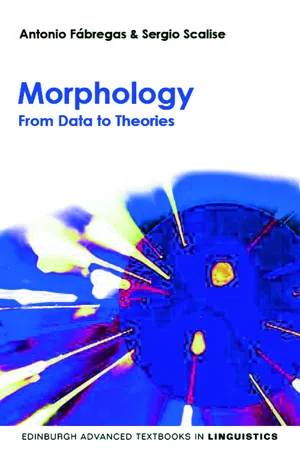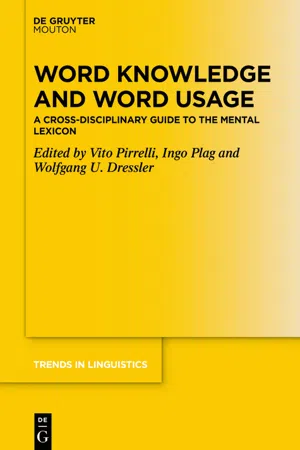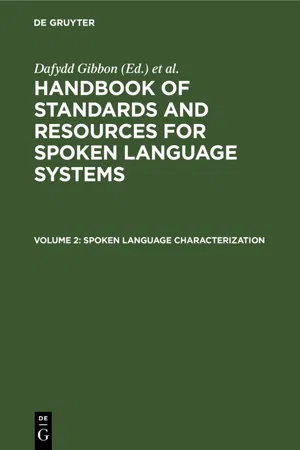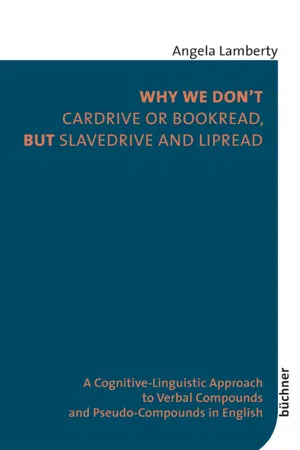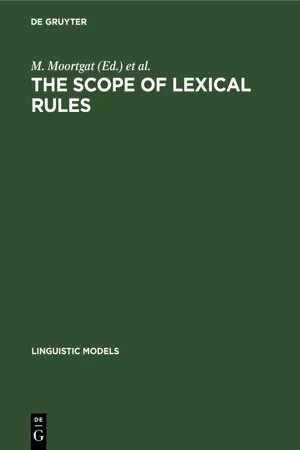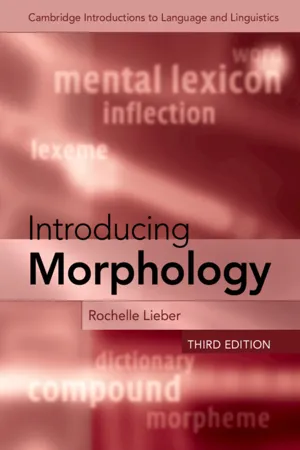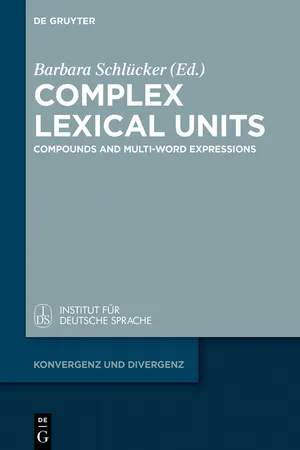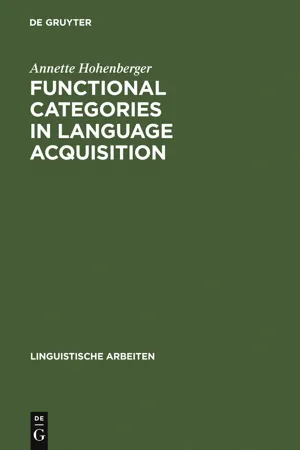Languages & Linguistics
Compounding
Compounding refers to the process of combining two or more words to create a new word with a distinct meaning. In linguistics, compounding is a common method of word formation found in many languages. It involves joining together individual words to form a single unit, often resulting in a compound noun, adjective, or verb.
Written by Perlego with AI-assistance
Related key terms
1 of 5
11 Key excerpts on "Compounding"
- eBook - PDF
Morphology
From Data to Theories
- Antonio Fábregas, Sergio Scalise(Authors)
- 2012(Publication Date)
- Edinburgh University Press(Publisher)
111 6 Compounding AND OTHER WORD- FORMATION PROCESSES 6.1 PROPERTIES OF COMPOUNDS Compounding is a word-formation process that combines two or more roots inside the same word. The relation which is established between the elements combined inside a compound is generally not very different from the relations seen between phrases in syntax: modification, coordination or subordination (as we will see in §6.2.). Additionally, the distinction between phrases and words is not as sharp in com-pounding as it is in inflection or derivation (see §6.3). All of these characteristics invite a view of Compounding as a morphological operation which is close to syntax. Some authors (Jackendoff 2007) have argued, even, that Compounding might reflect some kind of primitive syntax which is able to create a more complex structure by combin-ing units which are morphologically independent, as in the cases in (1), without intro-ducing functional material, such as determiners ( the , a ) or prepositions ( of ). (1) a. police dog b. apple pie c. razor sharp d. pick pocket Nature of the units combined Given the fact that police , dog , apple , and pie are not morphologically bound forms, Compounding – judging from (1) – does not seem too far away from a protosyntax that assembles words into more complex structures. However, this conclusion is not uncontroversial, and if we examine morphologically richer languages, we see that compounds do not always contain syntactically independent objects. The cases in (1) are called root compounds, because the objects combined within them are identical to morphological roots. In English, the root and the word can be the same, but in a language with stems (§2.4.1) and rich inflection, like Spanish, a root compound does not involve the combination of syntactically free objects. - eBook - PDF
Word Knowledge and Word Usage
A Cross-Disciplinary Guide to the Mental Lexicon
- Vito Pirrelli, Ingo Plag, Wolfgang U. Dressler, Vito Pirrelli, Ingo Plag, Wolfgang U. Dressler(Authors)
- 2020(Publication Date)
- De Gruyter Mouton(Publisher)
In this way, Compounding of-fers special insight into the representation and processing of multimorphemic words across languages. Compounds are prevalent across languages, they often play an important role in the creation of new words within a language, and the major constituents of compound words are typically easily identified by native speakers. These properties make Compounding an ideal candidate for the cross-Gary Libben, Brock University Christina L. Gagné, University of Alberta Wolfgang U. Dressler, University of Vienna; Austrian Academy of Sciences Open Access. © 2020 Gary Libben et al., published by De Gruyter. This work is licensed under a Creative Commons Attribution-NonCommercial-NoDerivatives 4.0 International License. https://doi.org/10.1515/9783110440577-009 linguistic investigation of the effects of positional, morphological, and semantic factors in lexical representation and processing. In the sections below, we examine these factors through an integrated lens with which we strive to bring together linguistic and psycholinguistic insights into the role of Compounding in lexical ability and the organization of the mental lexicon. We begin in Section 2 below with perspectives on the overall nature of Compounding. In Section 3, we discuss semantic issues, focusing on trans-parency. This is followed by a discussion of more formal aspects of compound constituency (Sections 4, 5, 6) and, in Section 7, the effects of productivity in representation and processing. We discuss the acquisition of Compounding in Section 8 and conclude with a summary statement concerning the evidence to date on the representation and processing of compound words in the mind. 2 The nature of Compounding 2.1 Deceptive simplicity Compounding is perhaps the simplest of morphological phenomena. Yet, it is often the things that appear to be the simplest that turn out to be the most reveal-ing. A compound such as boxcar seems exceedingly straightforward. - eBook - PDF
- Dafydd Gibbon, Roger Moore, Richard Winski, Dafydd Gibbon, Roger Moore, Richard Winski(Authors)
- 2020(Publication Date)
- De Gruyter Mouton(Publisher)
Compounding (composition) is that part of word formation which deals with the construction of words by concatenating words or stems. SIMPLE MORPHOLOGICAL UNITS: Traditional terminology varies in this area. A standard but incomplete definition of a morpheme, for instance, is that it is the minimal meaning-beaxing unit of a language. This definition is not entirely satisfactory, however, and for present purposes the sign-based model and the unit of word will be used as the starting point. A morpheme is the smallest abstract sign-structured component of a word, and is assigned representations of its meaning, distribution and surface (or-thographic and phonological) properties. More informally, morphemes axe parts of words defined by criteria of form, distribution and meaning; i.e. they have meanings and are realised by orthographic or phonological forms (morphs). They have no internal morphological structure. Traditionally, the two main kinds of morpheme are: • Lexical morphemes, characterised by membership of a large, poten-tially open class, with meanings such as properties and roles of ob-jects, states and events. Spoken language léxica [215] 69 • Grammatical morphemes, characterised by membership of a closed class, defined by their distribution with respect to larger units such as sentences or complex words (e.g. inflectional and derivational end-ings; function words such as prepositions, articles). Morphs axe, in traditional linguistics, the orthographic or phonologi-cal forms (realisations) of morphemes. Orthographic morphs consist of graphemes (either single letters or fixed combinations of letters); in tra-ditional phonology, phonological morphs consist of phoneme sequences with a prosodic pattern (e.g. word stress). Roots or bases (lexical morphs) are the morphs which realise lexical mor-phemes and inflectable grammatical morphemes, and function as the small-est type of stem in derivation and Compounding. - eBook - PDF
Word-Formation in the World's Languages
A Typological Survey
- Pavol Štekauer, Salvador Valera, Lívia Kőrtvélyessy(Authors)
- 2012(Publication Date)
- Cambridge University Press(Publisher)
PART II Cross-linguistic analysis 51 3 Word-formation processes combining free morphemes The study of language universals has been a major focus of modern linguistics for at least the past three decades. (Hawkins 1988: 3) If the above quotation holds true, at present we may extend the period of intensive research into language universals and language typology to fifty years. Of that, comparatively little attention has been devoted to word- formation. In our research into typology in word-formation we primarily follow Anderson’s (1985: 9) view of typological studies (cf. ‘Antecedents’ in the ‘Introduction’). For this reason, one of our objectives has been to identify/ verify associations between language families, inflectional types, and word order with respect to word-formation processes and categories. This chapter focuses on word-formation processes combining morphemes and devotes a section to Compounding (3.1), reduplication (3.2) and blend- ing (3.3). Emphasis is laid on Compounding, with a review of different types and processes within Compounding. 3.1 Compounding Libben (2006: 2) considers Compounding a language universal, and in some languages Compounding is reported to be extremely productive: according to the data in Ceccagno and Basciano (2009), approximately 80 per cent of Chinese words are compounds and over 90 per cent of all new words in The Contemporary Chinese Dictionary (Yuan, Zhang and Chen 2002) are compounds. In the study sample, Compounding is recorded in the languages shown in Table 3.1 (90.91 per cent in the study sample): Table 3.1. - eBook - PDF
Why We Don't Cardrive or Bookread, but Slavedrive and Lipread
A Cognitive-Linguistic Approach to Verbal Compounds and Pseudo-Compounds in English
- Angela Lamberty(Author)
- 2014(Publication Date)
- Büchner-Verlag(Publisher)
3.1 The birth of new words The vocabulary of the English language is not a static system, but subject to constant change due to the addition of new lexemes and the loss of obsolete words. Compounding of two free lexical mor-phemes is only one possibility among a variety of word-formation patterns the English language has at its disposal (Schmid 2011b, 69– 70). Irrespective of the nature of the word-formation pattern underlying it, a novel lexeme necessarily starts out as an ad-hoc formation when it is first being used by a speaker or writer. Following this first occurrence, it has to pass through various stages before it finally becomes a fully established lexeme. These stages are 1. creation, 2. consolidation, and 3. establishment (Schmid 2005, 72– 73; also Schmid 2011b, 70–71). Depending on whether a structural, 74 T OWARDS A C OGNITIVE -L INGUISTIC A PPROACH socio-pragmatic or cognitive perspective is adopted, the processes involved can be called ‘Lexicalization’, ‘Institutionalization’ , or ‘Hypostatization’ (Schmid 2005, 73; Schmid 2008, 3). Under these headings, the following three subchapters will provide some further information concerning the establishment of new lexemes. In this context, the approach put forward by Schmid (2005; 2011b) will be adopted. 3.1.1 Lexicalization In English, Compounding is one of the most frequent word-formation patterns that satisfies the need for new words. From a structural point of view, a word can be said to be lexicalized, i.e. inte-grated into the lexicon, once it has passed through the processes of creation and consolidation and reached the stage of being fully estab-lished (Schmid 2005, 79). In a more general sense, lexicalization is regarded as a gradual process and—at least according to Lipka— necessarily dependent on the frequency of usage of the respective lexeme (Lipka 1981, 120). - eBook - PDF
- M. Moortgat, H. v. d. Hulst, T. Hoekstra, M. Moortgat, H. v. d. Hulst, T. Hoekstra(Authors)
- 2020(Publication Date)
- De Gruyter Mouton(Publisher)
A similar demonstration of the autonomy of word syntax can be made on the basis of affixation. The reader is referred to Selkirk (forthcoming), where English affixation is examined, and it is shown that the general theoretical framework proposed here permits an illuminating characteri-zation of the significant properties of affixes and the structures containing them. Section 2: Compounding 2.1. Compounds in English are constituents of morphological structure which are made up of two elements belonging to the categories noun, adjective, verb, or preposition; the compound itself may belong to the category noun, adjective, or verb. (See Marchand (1969), Adams (1973), and Jespersen (MEG) for excellent de-scriptions of Compounding in English.) The vast majority of compound types in English contain as the righthand member a constituent which is of the same cate-gory as the compound itself. For the moment we will limit our attention to these. ENGLISH Compounding 239 As the examples in (10) - (12) show, a compound noun may be constituted of a noun, adjective, preposition, or verb on the left and a noun on the right, a compound adjective may consist of first a noun, adjective, or preposition and then an adjective, and a compound verb may consist of a preposition and then a verb: (10) Houns a. N N apron string sun shine mill wheel hub cap living room fighter bomber tongue lashing teacher training school teacher bull's eye b. A N high school small pox sharp shooter well wisher c. p N overdose underdog out building up rising on looker after thought up town in land d. V N swear word whet stone scrub woman rattle snake (11) Adjectives a. N A head strong honey sweet skin deep nation wide sea faring mind boggling earth bound heart broken b. A A icy cold white hot worldly wise easy going hard working high born wide spread far fetched c. P A overwide overabundant underripe ingrown underprivileged abovementioned d. - eBook - PDF
- Rochelle Lieber(Author)
- 2021(Publication Date)
- Cambridge University Press(Publisher)
But native speakers of English (and of course other languages) are remarkably exuberant in the way that they combine different types of word formation strategies to create wonderfully complex words. Consider, for example, the words in (42). (42) Such words show us that we can form new words with several prefixes or suffixes or a mixture of the two and that both simple bases and com- pound bases may take prefixes and suffixes. And we can even take com- pounds of one category and change them to another using conversion, as the examples in (42f) suggest. 3.7 Minor Processes Affixation, Compounding, and conversion are the most common ways of forming new words, at least in English (we will see in Chapter 5 that there are other means of word formation that languages other than a. multiple suffixes: weaklingdom, ducklingish, institutionalize b. multiple prefixes: hypermultilateralize, super-mega- omni-prayer, micronanosecond c. multiple prefixes and suffixes: reinstitutionalization, counterreformational d. suffixes on compound words: bestsellerdom, basketballer, dotcomist, girlfriendless e. prefixes on compound words: ex-ballplayer, mega-earthquake, unfootnoted f. compound words that have undergone conversion: to blacklist, to breakfast, a stir-fry, 3.7 Minor Processes 61 English use). In addition, there are a number of less common ways in which new lexemes may be formed. We provide a survey of them here, without going into great depth on any one of them. 3.7.1 Coinage It is of course possible to make up entirely new words from whole cloth, a process called coinage. However, it turns out that we coin completely new words relatively rarely, choosing instead to recycle bases and affixes into new combinations. - eBook - ePub
Complex Lexical Units
Compounds and Multi-Word Expressions
- Barbara Schlücker(Author)
- 2019(Publication Date)
- De Gruyter(Publisher)
Section 3.2 ). For a constructionist analysis for quasi-noun incorporation in Dutch, see Booij (this volume).3.7Discussion
This section is devoted to a discussion and summary of the preceding sections. The first, very simple observation is that all languages examined here have morphological compounds. However, it turned out that the compounds in these languages do not all share the same defining properties. While lexical (compound) stress, headedness (either right or left), inseparability and debarment of word-internal inflection, recursiveness, and linking elements are generally considered essential criteria for the definition of compound, in particular from a German(ic) perspective, all of them also emerged as problematic in at least one language, or as non-existent.27 Thus, it seems that there is no universal definition of compound. Rather, as pointed out by Ralli (2013b: 184):What makes a compound morphological should be defined on a language-specific basis, since languages vary with respect to the realization of their morphological features and the use of morphologically-proper units.Although it is ultimately impossible to weigh the various criteria against each other, it seems that Compounding in German is – hardly surprisingly given the genetical relation – particularly similar to Dutch as well as the continental North Germanic languages, but also to Greek.In addition to the defining criteria, also the number of compound subpatterns and the productivity of these patterns vary considerably between the languages. Verbal Compounding, for instance, is regarded as either unproductive or only marginally productive in most languages, in contrast however to Greek which has several productive verbal compound patterns. What all languages discussed here have in common is that nominal Compounding, and in particular N+N Compounding, is considered the most frequent and probably also the most productive compound type (cf. likewise Guevara/Scalise 2009 for a much larger language sample). - eBook - PDF
Poetic Compounds
The Principles of Poetic Language in Modern English Moetry
- Jean Boase-Beier(Author)
- 2010(Publication Date)
- De Gruyter(Publisher)
Compounding IN ENGLISH 3.1. The Place of Hord-For«ation in the Grauar of English In the present work we are concerned with a specific area of word formation in poetic language, namely the area of Compounding. Though there are poetic innovations in words formed by derivation, by far the most productive poetic word-formation process is that of Compounding. Because, as we have established in Chapter 1, PL is best characterised as the output of an interaction of poetic principles with the principles of the grammar, it is essential as a starting point in a discussion of poetic structures to give an outline of the grammar for the domain under discussion, grammar of Compounding generates as output well-formed non-poetical compound words. Thus an examination of poetic compounds which cannot be generated by this grammar, together with an examination of the grammar itself, will show what additional poetic means have been employed and will also indicate the nature of the interaction between these means and the grammar itself. Before we consider the exact nature of those parts of the grammar generating compounds, we shall make some general comments about the place of word-formation in the grammar. One central question in recent word-formation studies is the question as to the nature of word-formation rules and their similarity to or difference from other rule-types in the grammar. Closely connected with this is the question as to where word-formation takes place. There are basically two suggestions which can be put forward in this connection. One is that word-formation is not an autonomous component of the grammar and that principles at work in the syntax of the grammar are also at work in the area of word-formation. This was an important aspect of those early studies of word-formation within the framework of generative grammar which worked on the assumption that new words were generated by means of transformations (see, for example. Lees ( I 9 6 0 ) , Fräser ( 1 9 7 0 ) ) . - eBook - PDF
Functional Categories in Language Acquisition
Self-Organization of a Dynamical System
- Annette Hohenberger(Author)
- 2011(Publication Date)
- De Gruyter(Publisher)
233 the curves display the classical stage form, or saw-tooth form, pretransitory dips, whether they are steep of flat, etc., is epiphenomenal (see section 4.5.1.1). Let us now turn to some concrete examples of the precursor-successor relationship. While the examples discussed above (topicalization vs. passive voice, topic blends vs. embedding) are of the heterologous variety, I will concentrate on the homologous variety and follow the identical element through its dissipative history. 12.2 Compounding Compounding is one of the first grammtical capabilities of very young children. In fact, compound formation is characteristic of the transition from the one-word phase to the two-word phase and is mastered on a par with two-word utterances. In Keyser/Roeper (1993) the syntactic small VP with a small object as well as the τε-cases are both compounds. In Lebeaux (1988) this small VP, too, is seen as the first step the child takes on her way to phrasal syntax. The branch of lexical syntax in particular seems apt to capture these similarities. The intricate relationship between the lexicon and syntax which this approach advocates is par-ticularly appealing to dynamical systems theory in that the lexicon—passing a critical threshold of complexity—is expected to exhibit new qualities—qualities we use to call syntactic. Note, however, that Compounding, although it is so natural, easy and early observ-able in child language, is neither characteristic of every human language nor of human lan-guage alone (Helen Leuninger, p.c.). Languages vary with regard to the extent to which they use this device: compare, for instance, French and German: in the former language compounds are less frequent than in the latter. On the other hand, primates are known to be able to form two-word utterances, i.e., to compound (Fanselow 1985). So, compound for-mation is not yet true syntax, but a precursor. - eBook - PDF
- Jonathan Davis-Secord(Author)
- 2017(Publication Date)
- University of Toronto Press(Publisher)
22 Early work presumed that common compounds would lexicalize, leaving only very rare or “novel” (newly coined) compounds to be recognized and treated as complex words in mental processing. 23 However, according to recent experiments gauging eye-fixation times, lexical decision tasks, naming tasks, and other criteria, the brain processes even seemingly lexicalized compounds by decompos-ing them into constituents. 24 Subsequent experiments have shown that compounds in fact never fully lexicalize, insofar as the brain only ever activating the whole-word entry for a compound. 25 Rather, processing any compound involves both retrieving the lexical entries of the indi-vidual constituents (and constructing the relationship between them) as 21 For recent discussions of the theoretical frameworks of constituent computation versus whole-word storage, see chiefly Libben, “Why Study Compound Process-ing?”; Semenza and Mondini, “The Neuropsychology of Compound Words”; Heyvaert, “Compounding in Cognitive Linguistics”; and Gagné, “Psycholinguistic Perspectives.” 22 Lipka, “Lexicalization and Institutionalization,” 2165, defines “lexicalization” as follows: “the process by which complex lexemes tend to become a single unit, with a specific content, through frequent use.” For more recent discussions of defining “lexicalization,” see Lipka, Handl, and Falkner, “Lexicalization and Institutionalization,” and Bell and Plag, “Informativeness is a Determinant of Compound Stress in English,” 494–6.
Index pages curate the most relevant extracts from our library of academic textbooks. They’ve been created using an in-house natural language model (NLM), each adding context and meaning to key research topics.
